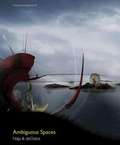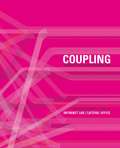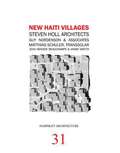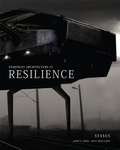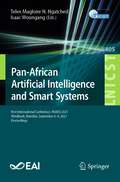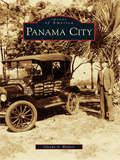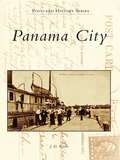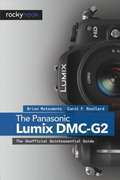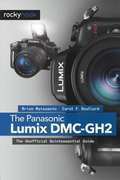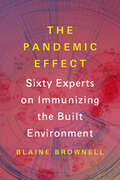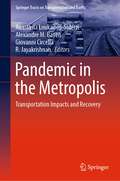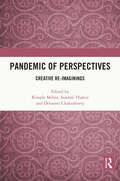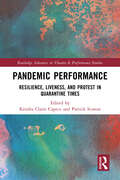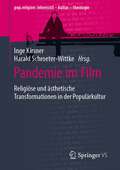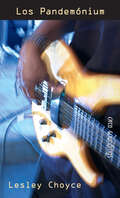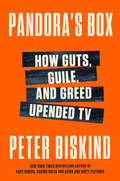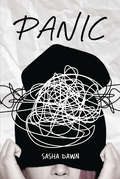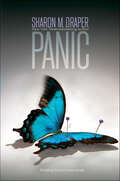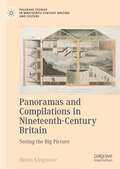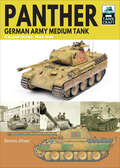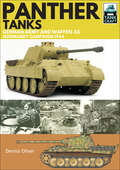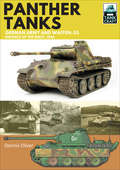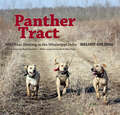- Table View
- List View
Pamphlet Architecture 29
by Ricardo De Ostos Nannette JackowskiAmbiguous Spaces, the newest installment in the Pamphlet Architecture series and a return to Pamphlet's own progressive roots, features the architectural fictions "The Pregnant Island" and "Nuclear Breeding." These two projects develop alternative urban concepts that address the challenges presented by the specific situations and social dynamics described in controversial locations such as the Brazilian Tucurui Dam, the Three Gorges Dam in China, and former English nuclear test sites. Using narrative techniques, fictional programs, ambiguous spaces, and building devices, Ambiguous Spaces explores people, communities, and even entire cities oppressed by a lack of freedom.
Pamphlet Architecture 30: Coupling: Strategies for Infrastructural Opportunism (Pamphlet Architecture)
by InfraNet Lab / Lateral OfficeParticipants in the Pamphlet Architecture 30 competition were asked to respond to the theme "Investigations in Infrastructure," and propose new directions for architecture, transportation, energy, cities, and agriculture at a continental scale. The winning entry, Coupling, imagined six daring projects: a high-speed rail system across the Bering Strait that also collects freshwater from the seasonal iceshelf; a decommissioned airport transformed into a geothermal data farm and agriculture site; thickening on/off ramps around "big box" stores into circular parking lots; a call to include landfills in the list of preserved open spaces; and a saline terminal lake turned into a water farm, recreational retreat, and habitat haven. Coupling argues that infrastructures behave as artificially maintained natural systems. Rather than a New Deal approach of massive engineering or iconic infrastructure, Coupling employs adaptable, responsive, small-scale interventions whose impacts are global in scale.
Pamphlet Architecture 31
by Steven HollHoll attempts to answer these questions with his idea for "Dense-Pack Villages," a type of courtyard housing that could be built with recycled concrete from fallen buildings and steel and would be hurricane- and earthquake-resistant. Each "village" could house approximately 200 occupants, and the courtyards would be filled with greenery and fruit trees. Holl proposes that these houses use solar cells on their roofs to provide electricity, allowing the villages to potentially operate off the grid. Water can be supplied from desalinization plants in each village, and also from new reservoirs, replacing the outdated reservoirs that were destroyed in the earthquake.
Pamphlet Architecture 32
by James A. Craig Matt Ozga-LawnThe competition for Pamphlet Architecture 32 centered on the theme of resilience. By addressing the capacity to cope, the ability to bounce back, and the mitigation and management of risk, participants were asked to showcase a fresh understanding of the architectural opportunities found in resilience. The winning entry successfully takes on the topic through an investigation of the ravaged city of Warsaw, Poland. By identifying, interrogating, and ultimately reinforcing both the physical and immaterial conditions of the landscape, the project allows the space to become something new and yet hold on to what it is, truly exhibiting resilience.
Pan-African Artificial Intelligence and Smart Systems: First International Conference, PAAISS 2021, Windhoek, Namibia, September 6-8, 2021, Proceedings (Lecture Notes of the Institute for Computer Sciences, Social Informatics and Telecommunications Engineering #405)
by Telex Magloire N. Ngatched Isaac WoungangThis book constitutes the refereed post-conference proceedings of the First International Conference on Pan-African Intelligence and Smart Systems, PAAISS 2021, which was held in Windhoek, Namibia, in September 2021. The 17 revised full papers presented were carefully selected from 41 submissions. The theme of PAAISS 2021 was “Advancing AI research in Africa” and the papers are arranged according to subject areas: Deep Learning; Classification and Pattern Recognition; Neural Networks and Support Vector Machines; Smart Systems.
Panama City (Images of America)
by Glenda A. WaltersFirst platted as Park Resort and later Harrison, Panama City received its current designation in 1909. More than 100 years ago, men of vision recognized the attractiveness and potential of this land along the shores of St. Andrews Bay, and those visionaries established a city that is now anticipating its centennial year. A local newspaper once reported that such men "saw that nature had dealt kindly with that section of the country and that with properly directed effort a great future awaited it." Others claimed the area was "nothing but a wilderness." Today nature's kindness to those who reside on these shores is apparent. This volume pays tribute to the city by recognizing the places, events, and, most importantly, the individuals who have inspired its success.
Panama City (Postcard History)
by J. D. WeeksPanama City began as three 640-acre homesteads in the late 1800s and was incorporated in 1909. The seat of Bay County, this thriving port city of nearly 156,000 is home to Tyndall Air Force Base and the Naval Coastal Systems Center. This volume contains more than 200 vintage postcard views of Panama City from its earliest years through the 1970s. Scenes of neighboring Panama City Beach include early beach institutions like the Hangout at Long Beach Resort, Jenkins Drive In, Mitties Tavern, and Little Birmingham. Those who remember the Fo'C'sle Grille at the Verde Mer Cottages in Laguna Beach deserve a gold star.
The Panasonic Lumix DMC-G2
by Brian Matsumoto Carol F. RoullardThe Panasonic Lumix DMC-G2: The Unofficial Quintessential Guide provides a wealth of information and professional insights for owners of this powerful HD camera. With its electronic viewfinder and interchangeable lenses, the G2 is capable of not only recording professional-quality still images, but has the added ability to record HD video as well. The mirrorless design enhances the camera's versatility beyond that of most digital single lens reflex (DSLR) cameras. With the appropriate adapters, it can use virtually any manufacturer's manual focus, legacy lens. It is smaller than a typical DSLR in both size and weight, and retains automatic focusing while recording videos - a capability missing in many DSLR cameras. Authors Brian Matsumoto and Carol Roullard explore and explain the features and capabilities of the G2 camera in detail, as they cover everything from the basic features of the camera to numerous advanced photographic applications. This informative text is illustrated with example images throughout. Use this guide to learn how to:Control the most basic camera functions - focus and exposure Navigate the camera's menu system Achieve a range of artistic effects using various camera settings Use the camera's automated controls, and how to override those controls to obtain better exposure Use the G2 in its video mode to obtain HD videos Post-process images and videos on a computer Expand the camera's use by mounting it on a telescope or microscope And much more...
The Panasonic Lumix DMC-GH2
by Brian Matsumoto Carol F. RoullardThe Panasonic Lumix DMC-GH2: The Unofficial Quintessential Guide provides a wealth of information and professional insights for owners of this powerful HD camera. With its electronic viewfinder and interchangeable lenses, the GH2 is capable of not only recording professional-quality still images, but has the added ability to record HD video as well. The mirrorless design enhances the camera's versatility beyond that of most digital single lens reflex (DSLR) cameras. With the appropriate adapters, it can use virtually any manufacturer's manual focus, legacy lens. It is smaller than a typical DSLR in both size and weight, and retains automatic focusing while recording videos capability that is missing in many DSLR cameras. With the GH2, Panasonic has significantly expanded the video capabilities beyond those of previous models. Among the improvements is the ability to adjust the frame rate and shutter speed when filming video, giving users greater control over the movie-making process. In this guide, authors Brian Matsumoto and Carol F. Roullard explore and explain the features and capabilities of the GH2 camera in detail, as they cover everything from the basic features of the camera to numerous advanced photographic applications. The informative text is illustrated with example images throughout. Readers will learn how to: Control the most basic camera functions-focus and exposure Navigate the camera's menu system Achieve a range of artistic effects using various camera settings Use the camera's automated controls, and override those controls to obtain better exposure Use the GH2 in its video mode to obtain HD videos Post-process images and videos on a computer Expand the camera's use by mounting it on a telescope or microscope And much more...
Panavia Tornado: Strike, Anti-Ship, Air Superiority, Air Defence, Reconnaissance & Electronic Warfare Fighter Bomber (Profiles of Flight)
by Dave Windle Martin W. BowmanThe Tornado has been the backbone of the RAF within its many different theaters of operation. The aircraft started as a European venture between Germany, Italy and the UK, based on the original swing-wing technology invented by Barnes-Wallis. It has also been successfully exported to several Middle-Eastern air forces. It is likely to remain in service for several years to come.This book contains the world famous color profiles created by Dave Windle of the type in different operational modes, configurations and color schemes. Martin Bowman has written detailed descriptions and photographs to create the perfect enthusiasts reference.
The Pandemic Effect: Ninety Experts on Immunizing the Built Environment
by Blaine BrownellIn The Pandemic Effect, 90 leading architects, designers, materials scientists, and health officials reflect on the influence of COVID-19 on buildings and cities—and propose solutions to safeguard the built environment from future pandemics, viruses, and contagious diseases on every scale, from surfaces to society. Safety and sustainability in buildings and cities have taken on new meaning during the COVID -19 pandemic. Buildings became magnifiers of contagion instead of shelters for protection. In this essential resource for both practitioners and students of architecture, interior design, and urban design, 90 of the world's leading experts investigate a variety of approaches to future-proof architecture and buildings against widespread disease. These inoculation strategies are organized into five chapters: "Histories" offers an overview of past pandemics and prior architectural approaches; "Inside / Outside" addresses the roles of building envelopes and mechanical systems in improving indoor environmental quality; "Interventions" consists of contemporary methods for direct prevention and control; "New Strategies" consists of various architectural analyses and proposals for design changes; and "The Public Realm" considers the urban landscape and related social questions. This broad collection of perspectives explores the transformations underway in the built environment—and offers design strategies to limit the severity of subsequent pandemics.
Pandemic in the Metropolis: Transportation Impacts and Recovery (Springer Tracts on Transportation and Traffic #20)
by Anastasia Loukaitou-Sideris Alexandre M. Bayen Giovanni Circella R. JayakrishnanThis book brings together reports of original empirical studies which explore the impacts of the COVID-19 pandemic on urban mobility and transportation and the associated policy responses. Focusing on the California region, the book draws on this local experience to formulate general lessons for other regions and metropolitan areas. The book examines how the COVID-19 pandemic has had different impacts on vulnerable populations in cities. It explores the pandemic's impacts on the transportation industry, in particular public transit, but also on other industries and economic interests that rely on transportation, such as freight trucking, retail and food industries, and the gig-economy. It investigates the effect of the viral outbreak on automobile traffic and associated air quality and traffic safety, as well as on alternative forms of work, shopping, and travel which have developed to accommodate the conditions it has forced on society. With quantitative data supported with illustrations and graphs, transportation professionals, policymakers and students can use this book to learn about policies and strategies that may instigate positive change in urban transport in the post-pandemic period.
Pandemic of Perspectives: Creative Re-imaginings
by Rimple Mehta Sandali Thakur Debaroti ChakrabortyThis volume brings together academics, activists, social work practitioners, poets, and artists from different parts of the world during the Covid-19 pandemic. It sheds light on how the pandemic has exposed the inequities in society and is shaping social institutions, affecting human relationships, and creating new norms with each passing day. It examines how people from diverse societies and fields of work have come to conceptualise and imagine a new world order based on the principles of social and ecological justice, care, and human dignity. It prioritises the realm of imagination, creativity, and affect in understanding social formations and in shaping societies beyond the positivist approaches. Documenting the myriad experiences and responses to the pandemic, the volume foregrounds varied processes of making meaning; understanding impulses, resistances, and coping mechanisms; and building solidarities. Further, it also acts as a tool of memory for future generations, and articulations- artistic, political, socio-cultural, scientific- of hope and perseverance. This spectrum of expressions intends to value visceral experiences, build solidarities, and find solace in art. Its uniqueness lies in the way it brings together a much-needed interface between science, social sciences, and humanities. A compelling account on our contemporary lives, the volume will be of great interest to scholars of sociology and social anthropology, politics, art and aesthetics, psychology, social work, literature, health, and medical sciences.
Pandemic Performance: Resilience, Liveness, and Protest in Quarantine Times (Routledge Advances in Theatre & Performance Studies)
by Kendra Claire CapecePandemic Performance chronicles the many ways that people are surviving/thriving through performance in a global pandemic. Covering artists and events from across the United States: from New York to California and from South Dakota to Texas, the chapters are equal parts theory and practice, weaving scholarship with personal experience from contributors who are interdisciplinary artists, scholars, journalists, and community organizers providing unique and invaluable perspectives on the complicated work of resilience during COVID-19. This study will hold interest for students and scholars in the performing arts, arts, and social justice as well as professional artmakers and creative community organizers.
Pandemie im Film: Religiöse und ästhetische Transformationen in der Populärkultur (pop.religion: lebensstil – kultur – theologie)
by Inge Kirsner Harald Schroeter-WittkeUntersucht wird die theologische und ästhetische Bearbeitung der Pandemien in dystopischen und Science-Fiction-Filmen sowie Serien. Zwischen Verschwörungstheorien, der Sicht als Strafe Gottes und der fatalistischen Annahme eines "notwenigen Übels" changieren die Erklärungsmodelle im Film wie auch in der gesellschaftlichen Wirklichkeit. Filme bieten dabei stellvertretend narrative Lösungsmodelle an. Die Katastrophe wird auf diese Weise dem beängstigenden Alltag für kurze Zeit enthoben, was eine der Reflexion zuträgliche Distanz ermöglicht. Exemplarisch wird ein sich wandelndes Rollen-, Gesellschafts- und Gottesbild aufgezeigt, das zu religionspädagogischen Reflexionen anregt.
Los Pandemónium: (Thunderbowl) (Spanish Soundings)
by Lesley ChoyceThunderbowl, la banda de Jeremy, es excelente, y acaba de conseguir su primera gran oportunidad: una serie de tocadas en el bar local. El problema es que Jeremy debería estar al corriente con sus trabajos para la escuela, pero pasa casi todas las noches en el escandaloso club tratando de mantener a la banda unida. Equilibrar los sueños de éxito con la realidad de la industria de la música obligará a Jeremy a tomar decisiones muy difíciles. Jeremy's band, Thunderbowl, is hot, and they have had their first big break—a long-term gig at a local bar. The problem is that while Jeremy should be keeping up with his school work, he is spending most nights in a rowdy club, trying to keep the band together. Balancing dreams of success with the realities of the music business force Jeremy to make tough choices.
Pandora's Box: How Guts, Guile, and Greed Upended TV
by Peter BiskindBestselling author of Easy Riders, Raging Bulls and Down and Dirty Pictures, cultural critic Peter Biskind turns his eye toward the new golden age of television, sparked by the fall of play-it-safe network TV and the rise of boundary-busting cable, followed by streaming, which overturned both—based on exclusive, candid, and colorful interviews with executives, writers, showrunners, directors, and actorsWe are now lucky enough to be living through the era of so-called Peak TV, in which television, in its various guises and formats, has seized the entertainment mantle from movies and dominates our leisure time. How and why this happened is the subject of this book. Instead of focusing on one service, like HBO, Pandora’s Box asks, “What did HBO do, besides give us The Sopranos?” The answer: It gave us a revolution. Biskind bites off a big chunk of entertainment history, following HBO from its birth into maturity, moving on to the basic cablers like FX and AMC, and ending up with the streamers and their wars, pitting Netflix against Amazon Prime Video, Max, and the killer pluses—Disney, Apple TV, and Paramount. Since the creative and business sides of TV are thoroughly entwined, Biskind examines both, and the interplay between them. Through frank and shockingly intimate interviews with creators and executives, Pandora’s Box investigates the dynamic interplay of commerce and art through the lens the game-changing shows they aired—not only old warhorses like The Sopranos, but recent shows like The White Lotus, Succession, and Yellow- (both -stone and -jackets)—as windows into the byzantine practices of the players as they use money and guile to destroy their competitors. In the end, this book crystal-balls the future in light of the success and failures of the streamers that, after apparently clearing the board, now face life-threatening problems, some self-created, some not. With its long view and short takes—riveting snapshots of behind-the-scenes mischief—Pandora’s Box is the only book you’ll need to read to understand what’s on your small screen and how it got there.
Panic
by Sasha DawnA page-turning story about a teen's struggle to overcome her fears on her quest for truth, strength, and stardom. Madelaine loves music, loves the stage, and loves performing. When she finds a fragment of poetry that inspires her to finish a song she's been writing, she tracks down the poem's author online in hopes of starting a collaboration. But as more pieces of the poem find their way to her, she realizes the online poet can't possibly be the one who's leaving them for her. At the same time, some shocking family secrets upend Madelaine's home life. As Madelaine struggles to separate the images people present online from the realities of who they are, her quest for truth, strength, and stardom takes turns she never expected.
Panic
by Sharon M. DraperThis gripping, chillingly realistic novel from New York Times bestselling author Sharon Draper, “by turns pulse-pounding and inspiring” (Kirkus Reviews), shows that all it takes is one bad decision for a dream to become a nightmare.Diamond knows not to get into a car with a stranger.But what if the stranger is well-dressed and handsome? On his way to meet his wife and daughter? And casting a movie that very night—a movie in need of a star dancer? What then?Then Diamond might make the wrong decision.It’s a nightmare come true: Diamond Landers has been kidnapped. She was at the mall with a friend, alone for only a few brief minutes—and now she’s being held captive, forced to endure horrors beyond what she ever could have dreamed, while her family and friends experience their own torments and wait desperately for any bit of news.From New York Times bestselling author Sharon Draper, this is a riveting exploration of power: how quickly we can lose it—and how we can take it back.
Panoramas and Compilations in Nineteenth-Century Britain: Seeing the Big Picture (Palgrave Studies in Nineteenth-Century Writing and Culture)
by Helen KingstoneThis book shows how in nineteenth-century Britain, confronted with the newly industrialized and urbanized modern world, writers, artists, journalists and impresarios tried to gain an overview of contemporary history. They drew on two successive but competing conceptual models of overview: the panorama and the compilation. Both models claimed to offer a holistic picture of the present moment, but took very different approaches. This book shows that panoramas (360° views previously associated with the Romantic period) and compilations (big data projects previously associated with the Victorian fin de siècle) are intertwined, relevant across the entire century, and often remediated, making them crucial lenses through which to view a broad range of genre and forms. It brings together interdisciplinary research materials belonging to different period silos to create new understandings of how nineteenth-century audiences dealt with information overload. It argues for a new politics of distance: one that recognizes the value of immersing oneself in a situation, event or phenomenon, but which also does not chastise us for trying to see the big picture. This book is essential reading for students and scholars of nineteenth-century literature, history, visual culture and information studies.
The Pantheon
by Tod A. Marder Mark Wilson JonesThe Pantheon is one of the most important architectural monuments of all time. Thought to have been built by Emperor Hadrian in approximately AD 125 on the site of an earlier, Agrippan-era monument, it brilliantly displays the spatial pyrotechnics emblematic of Roman architecture and engineering. The Pantheon gives an up-to-date account of recent research on the best preserved building in the corpus of ancient Roman architecture from the time of its construction to the twenty-first century. Each chapter addresses a specific fundamental issue or period pertaining to the building; together, the essays in this volume shed light on all aspects of the Pantheon's creation, and establish the importance of the history of the building to an understanding of its ancient fabric and heritage, its present state, and its special role in the survival and evolution of ancient architecture in modern Rome.
Panther German Army Medium Tank: Italian Front, 1944–1945 (TankCraft)
by Dennis OliverThe Allied invasions of Sicily and the Italian mainland had been met with tenacious resistance by the Germans but the defense consisted for the most part of armored units that were little different to those the British had faced in North Africa. But in early 1944, with the landings at Anzio and Nettuno and the attempt to bypass the German defensive line, the Wehrmacht’s high command began shipping heavier and more powerful tanks to the Southern Front including an increasing number Tigers and Panthers. The initial models of the latter had gone into combat for the first time in July 1943 and it was planned that every Panzer regiment would eventually contain a battalion of these impressive vehicles. Drawing on official documentation and unit histories Dennis Oliver investigates the formations that operated these deservedly famous vehicles and uses archive photos and extensively researched color illustrations to examine the markings, camouflage and technical aspects of the Pzkpfw V tanks that wee an integral part of the German defense of the Italian peninsula. A key section of his book displays available model kits and aftermarket products, complemented by a gallery of beautifully constructed and painted models in various scales. Technical details as well as modifications introduced during production and in the field are also examined, providing everything the modeler needs to recreate an accurate representation of these historic vehicles.
Panther Tanks: Germany Army and Waffen SS, Normandy Campaign 1944 (TankCraft)
by Dennis OliverHistory buffs, modelers, and wargamers will find &“authentic orders of battle and narratives of the actual situations these units faced in Normandy&” (Schopenhauer&’s Workshop). Central to the German strategy of dealing with an Allied landing in France was the availability of a strong, mobile armored reserve. In June 1944, as part of this force, the Army in the West was able to deploy over 300 Panther tanks, perhaps the best armored fighting vehicle produced by Germany during the Second World War. British and American tank crews found to their horror that the Panthers could often survive numerous hits while a single round from one of their 75mm guns was enough to destroy any enemy tank. In his third book in the TankCraft series, Dennis Oliver uses archive photographs and painstakingly researched, exquisitely presented color illustrations to examine the part these powerful tanks played in the Normandy battles and also the battalions that operated them. As with previous titles in the TankCraft series, a large part of this book showcases available model kits and aftermarket products and accessories, complemented by a gallery of skillfully constructed and painted models. &“As with other books in this series there are many excellent photographs and color drawings, with clear text providing all of the background information to the deployment and actions of the Panther in Normandy.&”—Firetrench &“Very much a modellers book but tied in so well with the details of the tank and the context of the history surrounding it. Good value and well worth adding to your reference shelf.&”—Military Model Scene
Panther Tanks: German Army and Waffen-SS, Defence of the West, 1945 (TankCraft)
by Dennis OliverA guide that blends the history behind the German World War II tank with resources for military vehicle modeling enthusiasts. In late 1944 and 1945, the Panther tank played an important role in Germany&’s desperate efforts to stem the Allied advance on the Western Front. The Panther, perhaps the best armored vehicle produced by Germany during the Second World War, was a key element in the Wehrmacht&’s defensive tactics, in rearguard actions and counterattacks, and it took a prominent part in the last German offensive of the war, in the Ardennes during the Battle of the Bulge. So it is an ideal subject for Dennis Oliver&’s latest volume in the TankCraft series. He uses archive photos and extensively researched color illustrations to examine the Panther tanks and units of the German army and Waffen-SS panzer battalions that struggled to resist the Allied onslaught. A key section of his book displays available model kits and aftermarket products, complemented by a gallery of beautifully constructed and painted models in various scales. Technical details as well as modifications introduced during production and in the field are also examined providing everything the modeler needs to recreate an accurate representation of these historic tanks. Praise for Panther Tanks &“A great book, especially for beginners and intermediate modelers, or those building their first Panther tank.&” —AMPS &“Technical details as well as modifications introduced during production and in the field are also examined providing everything the modeler needs to recreate an accurate representation of these historic tanks.&” —Military Vehicles
Panther Tract: Wild Boar Hunting in the Mississippi Delta
by Melody GoldingHunting wild boar is a keenly held tradition in the Mississippi Delta. Fraught with danger, it challenges the hunter, observer, wildlife enthusiast, and landowner alike. Panther Tract is an insider's observance of extraordinary hunting, southern hospitality, camaraderie, and the love of dogs, horses, and hair-raising excitement. The over 160 photographs are representative of a “day at the hunt,” starting at dawn and ending well after dark. The tales center on vivid hunting experiences, both at Panther Tract, a large wilderness paradise in Yazoo County, owned by legendary southern gentleman Howard Brent, and in other locations in the Mississippi Delta. The narratives come from men, women, doctors, lawyers, judges, businessmen, politicians, farmers, sharecroppers' sons, and even a Hollywood screenwriter. Melody Golding's photographs focus on the Delta landscape and on the people and animals involved in the hunt. Portraits of the hunters, and their interactions with one another and their dogs and horses, fascinate. An award-winning photographer and an expert horsewoman, Golding brings a knowledgeable and critical eye to these images. The stories she collects range from traditional often humorous hunting tales to more serious accounts of the history of hog hunting in America. Hank Burdine, a Mississippi native and hunter who has written for many statewide publications, lends a broad vision to the history, statistics, and lore of hunting wild hogs. An appendix features hunt recipes by Chef John Folse and philosophy on the stewardship of harvesting the hog. A colorful and diverse assemblage of beautiful photographs and tales, this book reveals a treasured regional tradition.
